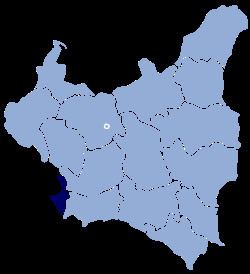1920–1939 → Government Autonomous voivodeship until 1939 Michał Grażyński Founded 15 July 1920 Population 1.534 million (1929) | Capital Katowice since 1922 Józef Rymer Established 15 July 1920 Area 5,100 km² Date dissolved October 8, 1939 | |
 | ||
The Silesian Voivodeship (Polish: Województwo Śląskie) was an autonomous province (voivodeship) of the interwar Second Polish Republic. It became part of the newly reborn Poland as a result of the 1921 Upper Silesia plebiscite, the Geneva Conventions, three Upper Silesian Uprisings, and the eventual partition of Upper Silesia between Poland, Germany and Czechoslovakia. At the time of its founding, it was inhabited by 110,659 ethnic Poles, 29,010 ethnic Germans, and 4,429 Jews according to Polish census of 1921. The capital of the voivodeship was Katowice.
Contents
The voivodeship was dissolved on October 8, 1939 following the German invasion of Poland, and its territory was incorporated into the German Province of Silesia. After the defeat of Nazi Germany in World War II, its territory was incorporated into a new, larger Silesian Voivodeship which existed until 1950.
General description
The Silesian Voivodeship was one of the richest and best developed provinces of inter-war Poland. It owed its wealth to rich deposits of coal, which resulted in construction of numerous coal mines and steelworks. For this reason, this Voivodeship was crucial to Polish armaments production. However, its location on the border with Germany made it vulnerable. In mid-1930s, the Polish government decided to move some sectors of heavy industry to the nation's heartland, creating the Central Industrial Region. Due to efficient agricultural practices, the Silesian Voivodeship also was a major producer of food, in spite of its small size.
According to the 1931 Polish census, 92.3% of population stated Polish as their mother tongue. Germans made up 7% and Jews only 0.5%. Poles lived mainly in the villages (95.6% of population there), while Germans and Jews preferred cities (12.9% of Polish Upper Silesian cities' population was German, especially Katowice).
Population density was the highest in the country at 299 persons per 1 km². On January 1, 1937, forested areas made up 27.9% of the province. Rail density was the highest in the country at 18.5 km. per 100 km². In 1931, the illiteracy rate was the lowest in the country at 1.5% of population.
History
After the First World War a dispute arouse aboute the future of Upper Silesia. This part of the Silesia region was the least affected by centuries of germanisation. The population was predominately Slavic, especially in rural areas. Many of them considered themselves Poles, and some Czechs. The rest did not feel any strong connections to either of those nations; according to Wojciech Korfanty's estimations, this last group represented up to a third of the total whole population of the region.
The Treaty of Versailles resolved that a plebiscite be conducted so that the local population could decide whether Upper Silesia should be assigned to Poland or to Germany. Before the plebiscite took place, two Silesian Uprisings supporting the Polish option broke out. There was a third uprising after the plebiscite, as well.
Based on the results of the plebiscite, Upper Silesia was divided between Poland and Germany. The Polish part was incorporated as the Silesian Voivodeship.
The voivodeship was one of the best economically developed parts of Poland. It had been granted autonomous status by an Act of the Polish Sejm dated 15 July 1920. This status was secure until the May Coup in 1926, after which there were various attempts to limit it in favor of a strong and centralised state.
Following the German invasion of Poland, the voivodeship was dissolved on October 8, 1939, and its territory was incorporated into the German Province of Upper Silesia. The territory came back into Polish possession at the end of the war, and the 1920 act giving autonomous powers to the Silesian Voivodeship was formally repealed by a law of 6 May 1945. An enlarged Silesian Voivodeship (unofficially called Silesia-Dąbrowa Voivodeship, województwo śląsko-dąbrowskie) continued in existence until 1950, when it was divided into Katowice Voivodeship and Opole Voivodeship. (For details, see Administrative division of the People's Republic of Poland.)
Politics
The voivodeship possessed wide autonomy in domestic matters excluding foreign and military policy. It had its own Silesian Parliament with 48 MPs (24 since 1935) elected in democratic elections. Legislation, however, had to be consistent with the Polish constitution. The voivodeship also had its own national treasury - the Silesian Treasury (Polish: Skarb Śląski). Only around 10% of taxes were transferred to Polish national treasury. The head of the administration was headed by a voivode appointed by the president of Poland to act as a representative of the central government.
Counties (powiaty)
In mid-1939, in the wake of invasion, the population of the voivodeship was 1,533,500 (together with Zaolzie, annexed in October 1938. Its total area was 5,122 square kilometres (1,978 sq mi). The voivodeship was divided into the following counties; with largest cities based on the 1931 population census).
